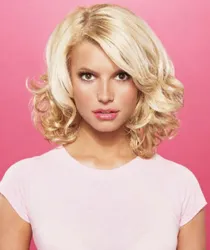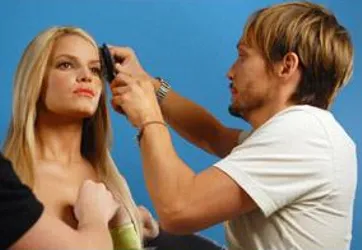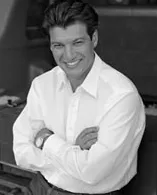
Hair Perm Scoops
Hair Perm Scoops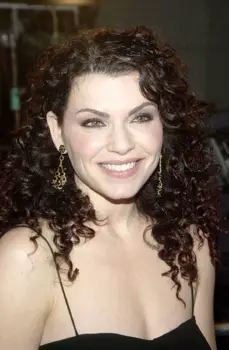 Julianna Margulies With Natural Curly Hair - Premiere of Warner Brothers "Ghost Ship" Mann Village Theater, Westwood, CA 10-22-02 - Photo courtesy of DC Media.com - All Rights Reserved
Julianna Margulies With Natural Curly Hair - Premiere of Warner Brothers "Ghost Ship" Mann Village Theater, Westwood, CA 10-22-02 - Photo courtesy of DC Media.com - All Rights ReservedWhether your ultimate hair goal is to remove unwanted texture or add desired curls ore related texture, a chemical perm treatment is sometimes utilized.
A chemical hair perm is also commonly referred to as a permanent wave or permanent.
A Hair Perm Breaks And Reforms Hair Bonds
A hair perm works very simply. It involves the use of chemicals to break and reform the bonds of the hair.
Hair is first wet washed with water, wrapped on a series of rods or specialized curlers, then doused with chemical waving lotion.
The chemical waving lotion creates a chemical reaction which softens the inner structure of the hair by breaking some of the cross links within and between the protein chains of the hair.
Hair Molds Around The Shape Of The Perm Rods
Once the solution is applied, the hair swells, stretches and softens, then molds around the shape of the perm rods.
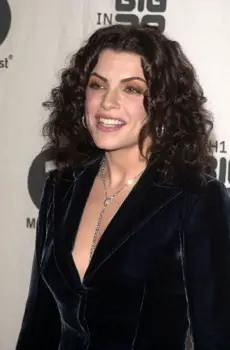 Julianna Margulies With Natural Curly Hair at the VHI Big in 2002 Awards Arrivals, Grand Olympic Auditorium, LA, CA. 12-04-02 - Photo Courtesy of DC Media.com - All Rights Reserved
Julianna Margulies With Natural Curly Hair at the VHI Big in 2002 Awards Arrivals, Grand Olympic Auditorium, LA, CA. 12-04-02 - Photo Courtesy of DC Media.com - All Rights ReservedDepending upon the size, shape and number of perm rods applied to the hair, once the perm processing is finished, new texture results.
Chemical Hair Straightening Is A Type Of A Perm
While a chemical hair perm will add new texture, it can also remove natural texture by straightening or relaxing it.
Chemical relaxing is a hair altering process first developed by Renaud Whittington.
This process makes use of the same chemical reactions as that of the permanent wave, but the hair is combed straight rather than wrapped around perm rods.
A Chemical Perm Can Not Solve All Your Hair Woes
 Julianna Margulies With Straightened Hair "The Trial"- Alicia (Julianna Margulies ) - THE GOOD WIFE, Sunday, Nov. 23 on the CBS Television Network. Photo: Jeff Neumann ©2014 CBS Broadcasting, Inc. All Rights Reserved
Julianna Margulies With Straightened Hair "The Trial"- Alicia (Julianna Margulies ) - THE GOOD WIFE, Sunday, Nov. 23 on the CBS Television Network. Photo: Jeff Neumann ©2014 CBS Broadcasting, Inc. All Rights ReservedWhile it might sound fabulous that you can instantly get waves and texture without a curling iron, you may not be aware of the other issues a hair perm may cause.
Since hair perms, whether to add texture or remove it, are chemically based, they may cause short or long term damage.
Hair may become chronically dry, result in uncontrollable frizz, splits and rips.
While there are some options you can utilize to neutralize the negative effects of any type of perm.
These options include:
1. Find a hairstylist who specializes in chemical perm treatments, either adding or removing texture.
2. A great stylist will understand the right rod size and the right kind of perm to achieve the best results for your hair type, natural texture and desired hairstyle.
3. Only have hair permed with is free of previous chemical applications (hair color, highlighting, lowlighting, perms etc.,).
4. If chemically treated hair is considered a good candidate for perm treatments, make sure you undertake pre-perm deep conditioning treatments.5. Inquire whether or not a custom conditioning formula can be adding to the perm solution to minimize potential damage.
6. Make sure to undertake a series of post-perm deep conditioning treatments.7. Perform meticulous post-perm maintenance including having damaged ends removed.
8. Amp up post-perm hydration treatments including utilizing both internal and external formulas.9. Start slowly. Consider having only a small amount of hair permed to evaluate the results.
Always Have A Pre-Perm Patch Test Performed
Whether you have just a small amount of hair permed or not, always insist upon a patch test to make sure you're not allergic in any way to the chemical formula utilized.
Summary - Hair Perm Scoops
Hair perms, whether to add or remove texture, can be challenging if all the proper options are considered and weighed.
Before agreeing to have a hair perm applied to your tresses, do your research and consider all the pros and cons.
Find photos of how you want your hair to look after the perm.
Whatever you do, don't throw away your irons because you never know when you might need them again.Social Media Network Information
Please follow us on Twitter at: https://Twitter.com/HairBoutique. I look forward to meeting new people from all walks of Twitter and learning from their Tweets.




